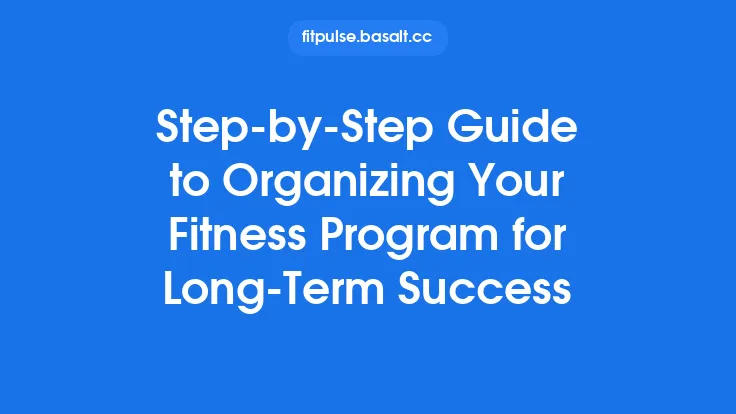When you step onto the gym floor, lace up your running shoes, or roll out a yoga mat, the physical actions you take are only part of the story. What truly fuels lasting commitment is the deeper “why” that sits behind every rep, mile, or stretch. Aligning your personal values with your fitness objectives transforms a routine into a purposeful practice, turning fleeting motivation into enduring habit. Below, we explore how to uncover those core values, translate them into meaningful fitness objectives, and weave them seamlessly into a training program that feels authentic, sustainable, and rewarding.
Understanding Personal Values
1. What Are Values?
Values are the principles and beliefs that guide your decisions, shape your identity, and give meaning to your life. They can be broad (e.g., health, community, environmental stewardship) or specific (e.g., “I value being a role model for my children”). Unlike goals, which are concrete outcomes, values are enduring and often operate at a subconscious level.
2. Why Values Matter in Fitness
When a fitness objective resonates with a core value, the brain releases dopamine not just for the achievement itself but for the affirmation of identity. This neuro‑psychological feedback loop makes the behavior more intrinsically rewarding, reducing reliance on external motivators like praise or competition.
3. Identifying Your Core Values
- Values‑Clarification Exercise: Write down everything that matters to you—relationships, career aspirations, personal growth, societal impact, etc. Then, rank them on a scale of 1–10 based on how strongly you feel they define you.
- Reflect on Peak Moments: Recall times when you felt most alive or proud. What underlying principle was at play?
- Use Established Frameworks: Tools such as the Rokeach Value Survey or Schwartz’s Value Theory can provide structured categories (e.g., self‑direction, benevolence, achievement) to help you pinpoint where you sit.
Mapping Values to Fitness Objectives
1. From Abstract to Concrete
Take each high‑ranking value and ask, “How could a fitness activity embody this value?” For example:
- Value: Community → Objective: Join a local running club or lead a weekly group workout.
- Value: Environmental Stewardship → Objective: Cycle to work three times a week, reducing carbon emissions while staying active.
2. Prioritization Without Traditional Goal Hierarchies
Instead of labeling goals as “primary” or “secondary,” rank them by the intensity of value alignment. A fitness objective that strongly reflects a top‑tier value should receive more planning resources (time, equipment, coaching) than one that aligns less directly.
3. Compatibility Check
Ask yourself:
- Does this objective reinforce my value, or does it feel like a compromise?
- Will pursuing this objective create cognitive dissonance (e.g., training for a marathon while valuing family time equally)?
If the answer leans toward dissonance, consider re‑framing the objective or selecting an alternative that better fits your value matrix.
Techniques for Values‑Driven Goal Formulation
1. The “Values‑Action” Statement
Craft a concise sentence that links a value to a specific fitness action.
Example: “Because I value resilience, I will practice progressive overload in my strength training three times per week.”
This statement serves as a mental anchor during moments of doubt.
2. The “If‑Then” Planning Model
Use implementation intentions to bridge values and behavior:
- If I feel tempted to skip a workout after a long workday, then I will remind myself that staying active honors my commitment to personal health, which underpins my ability to care for my family.
Research shows that “if‑then” plans improve adherence by automating the decision‑making process.
3. Integrating Narrative Identity
Write a short narrative describing yourself as the person who lives your values through fitness.
“I am a lifelong learner who uses movement to explore my body’s capabilities, staying curious and adaptable.”
Revisiting this story reinforces self‑consistency, a powerful driver of sustained behavior.
Integrating Values into Program Design
1. Choose Modalities That Echo Your Values
- Community‑Oriented: Team sports, group classes, charity runs.
- Self‑Improvement: Skill‑based disciplines like gymnastics, martial arts, or progressive weight training.
- Eco‑Conscious: Outdoor activities (hiking, trail running), bodyweight circuits in parks, or using sustainable equipment.
2. Schedule with Value‑Based Priorities
Allocate training slots that protect your most important values. If family time is paramount, schedule workouts that involve family members (e.g., bike rides together) or place them at times that do not conflict with family commitments.
3. Embed Value Reinforcement Cues
- Visual Reminders: Post a photo of a community event you love near your workout space.
- Auditory Triggers: Use playlists that include songs with lyrics reflecting your values (e.g., empowerment anthems for the value of self‑determination).
- Environmental Design: Set up a home gym with recycled materials if sustainability is a core value.
Monitoring Alignment Over Time
1. Periodic Values‑Fitness Audits
Every 4–6 weeks, review your training log alongside a values checklist. Ask:
- Which sessions felt most aligned?
- Were there moments of conflict?
- Did any new values emerge that should influence upcoming programming?
2. Quantitative and Qualitative Metrics
- Quantitative: Track adherence rates, session intensity, and recovery markers.
- Qualitative: Use a simple 1–5 “Alignment Rating” after each workout (1 = felt disconnected, 5 = fully embodied my values). Over time, trends in this rating can signal whether your program remains congruent with your evolving self.
3. Adaptive Re‑Design
If alignment scores dip consistently, consider adjusting:
- Modality: Switch from solo cardio to a group class.
- Frequency: Reduce volume to protect a value like work‑life balance.
- Goal Scope: Refine the “values‑action” statement to better capture the intended purpose.
Overcoming Misalignment Challenges
1. Value Conflict Resolution
When two values clash (e.g., career advancement vs. personal health), employ a value hierarchy exercise: rank them in the current life stage and negotiate compromises. For instance, you might schedule shorter, high‑intensity workouts that preserve time for professional tasks while still honoring health.
2. Dealing with External Pressure
Friends or social media may push you toward fitness trends that don’t reflect your values. Use motivational interviewing techniques on yourself:
- “What would you gain by following this trend?”
- “How does it serve your deeper purpose?”
If the answer is weak, politely decline.
3. Managing Value Drift
Values can evolve—what mattered at 25 may shift at 35. Treat your values inventory as a living document. Re‑assess annually, and be willing to pivot your fitness objectives accordingly.
Case Studies and Practical Examples
Case 1 – The Eco‑Conscious Runner
Values: Environmental stewardship, personal health, community involvement.
Values‑Action Statement: “Because I care about the planet, I will run on local trails and organize monthly “plogging” runs (picking up litter while jogging).”
Program Design: 3 weekly runs (2 trail, 1 interval), plus a monthly community clean‑up run. Alignment rating averaged 4.8/5, with high satisfaction from both personal health and environmental impact.
Case 2 – The Family‑Focused Parent
Values: Family connection, resilience, lifelong learning.
Values‑Action Statement: “I will incorporate my children into my strength training by using bodyweight circuits that we can do together.”
Program Design: 2 family circuit sessions per week, focusing on functional movements (squats, push‑ups, plank variations). The parent reported increased bonding and a sense of modeling healthy habits, scoring 5/5 on alignment.
Case 3 – The Career‑Driven Professional
Values: Professional excellence, mental clarity, personal growth.
Values‑Action Statement: “I will practice yoga three times a week to enhance focus and reduce stress, supporting my performance at work.”
Program Design: Short (30‑minute) morning yoga flow, supplemented by weekly mindfulness workshops. Alignment scores remained steady, and the professional noted improved concentration and reduced burnout.
Tools and Resources for Values Alignment
| Resource | Description | How It Supports Alignment |
|---|---|---|
| Values‑Clarification Worksheets (e.g., VIA Survey) | Structured questionnaires to identify top personal values. | Provides a concrete list to map onto fitness objectives. |
| Implementation Intention Apps (e.g., If‑Then Planner) | Mobile tools for creating “if‑then” plans with reminders. | Automates the cue‑response loop, reinforcing value‑driven actions. |
| Fitness Journals with Reflection Sections | Journals that include prompts for “How did this session reflect my values?” | Encourages regular self‑assessment and deeper integration. |
| Community Platforms (e.g., Meetup, Strava Clubs) | Online groups centered around shared interests (e.g., eco‑runs, family fitness). | Connects you with like‑minded individuals, amplifying value resonance. |
| Biofeedback Devices (e.g., HRV monitors) | Track physiological stress and recovery. | Allows you to see if value‑aligned activities also support overall well‑being. |
Bringing It All Together
Aligning personal values with fitness objectives is less about ticking boxes and more about crafting a narrative where movement becomes an expression of who you are. By systematically uncovering your core values, translating them into concrete fitness actions, and embedding those actions into a thoughtfully designed program, you create a self‑reinforcing loop: each workout validates your identity, and each validated identity fuels the next workout.
Remember that alignment is dynamic. As life circumstances shift, revisit your values inventory, adjust your “values‑action” statements, and fine‑tune your training plan. When you treat fitness as a living embodiment of your deepest principles, the journey becomes not just a path to a stronger body, but a roadmap to a more authentic, purposeful life.



